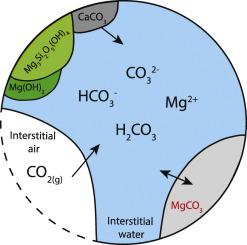当前位置:
X-MOL 学术
›
Chem. Geol.
›
论文详情
Our official English website, www.x-mol.net, welcomes your feedback! (Note: you will need to create a separate account there.)
Atmospheric carbon sequestration in ultramafic mining residues and impacts on leachate water chemistry at the Dumont Nickel Project, Quebec, Canada
Chemical Geology ( IF 3.9 ) Pub Date : 2020-07-01 , DOI: 10.1016/j.chemgeo.2020.119661 A. Gras , G. Beaudoin , J. Molson , B. Plante
Chemical Geology ( IF 3.9 ) Pub Date : 2020-07-01 , DOI: 10.1016/j.chemgeo.2020.119661 A. Gras , G. Beaudoin , J. Molson , B. Plante

|
Abstract Passive carbon mineralization in ultramafic mining residues, which allows the sequestration of CO2 through carbonate precipitation, is one of the options being considered to limit the accumulation of anthropogenic CO2 in the atmosphere. The Dumont Nickel Project (DNP) will generate approximately 1.7 Gt of utramafic mining residues over 33 years of production and the mine will release about 127,700 tonnes of CO2 each year. Using two experimental cells filled with ultramafic waste rock (EC-1) and milling residues (EC-2), the impacts of carbon mineralization on leachate water quality were studied and the quantity of sequestered carbon was estimated. Hydrotalcite supergroup minerals, aragonite, artinite, nesquehonite, dypingite and hydromagnesite precipitated through atmospheric weathering, while the inorganic carbon content of the weathered mining waste increased from 0.1 wt% to 4.0 wt%, which indicates active CO2 sequestration. The leachate water, sampled at the bottom of the experimental cells, is characterized by an alkaline pH (~9.5), a high alkalinity (~90 to ~750 mg/L) and a high concentration of magnesium (~50–~750 mg/L), which is typical from weathering of ultramafic rocks in a system open to CO2. Since 2012, the chemical composition of the leachate water has evolved seasonally. These seasonal variations are best explained by: (1) climatic variations over the year and, (2) increased carbonate precipitation between May and July. Increased carbonate precipitation decreased the alkalinity and magnesium concentrations in the leachate water and produced pore waters which were undersaturated with respect to carbonate minerals such as artinite and hydromagnesite. Carbonate precipitation thus self-limits carbon sequestration through a negative feed-back loop. The carbon sequestration potential of the DNP residues is also influenced by the hydrogeological properties of the residues. In cell EC-2, a high liquid/solid ratio, which limits carbonate precipitation, was maintained by the hydrogeological properties. Since 2011, an estimate of 13 kg of atmospheric CO2 has been sequestered in the milling residues (EC-2), which corresponds to a mean rate of 1.4 (±0.3) kgCO2/tonne/year. Using this mean rate, the 15 Mt of tailings produced each year, during the planned 33 years of mining operation, could potentially sequester 21,000 tonnes of CO2 per year by passive carbon mineralization, about 16% of the 127,700 tonnes of CO2 annually emitted by the planned mining operation.
中文翻译:

加拿大魁北克杜蒙镍项目中超镁铁矿残渣中的大气碳封存及其对渗滤液水化学的影响
摘要 超镁铁矿残渣中的被动碳矿化允许通过碳酸盐沉淀封存 CO2,是限制人为 CO2 在大气中积累的选择之一。杜蒙镍矿项目 (DNP) 将在 33 年的生产过程中产生约 1.7 吉吨超镁铁矿残渣,该矿每年将排放约 127,700 吨二氧化碳。使用两个充满超镁铁质废石 (EC-1) 和研磨残渣 (EC-2) 的实验单元,研究了碳矿化对渗滤液水质的影响,并估算了固碳量。通过大气风化沉淀的水滑石超群矿物、文石、砭石、三菱镁矿、水滑石和水菱镁矿,而风化采矿废物的无机碳含量从 0.1 wt% 增加到 4.0 wt%,这表明 CO2 封存活跃。在实验池底部取样的渗滤水具有碱性 pH (~9.5)、高碱度 (~90 至 ~750 mg/L) 和高浓度镁 (~50–~750 mg /L),这是典型的超基性岩在对 CO2 开放的系统中风化的结果。自 2012 年以来,渗滤液水的化学成分发生了季节性变化。这些季节性变化的最佳解释是:(1) 全年气候变化,(2) 5 月和 7 月之间碳酸盐降水增加。碳酸盐沉淀的增加降低了渗滤水中的碱度和镁浓度,并产生了相对于碳酸盐矿物(如砭石和水菱镁矿)不饱和的孔隙水。因此,碳酸盐沉淀通过负反馈回路自我限制碳封存。DNP 残留物的固碳潜力也受残留物的水文地质特性的影响。在单元格 EC-2 中,水文地质特性维持了限制碳酸盐沉淀的高液/固比。自 2011 年以来,估计有 13 千克大气 CO2 被隔离在研磨残留物 (EC-2) 中,这对应于 1.4 (±0.3) 千克 CO2/吨/年的平均速率。使用这个平均速率,每年生产的 15 吨尾矿,
更新日期:2020-07-01
中文翻译:

加拿大魁北克杜蒙镍项目中超镁铁矿残渣中的大气碳封存及其对渗滤液水化学的影响
摘要 超镁铁矿残渣中的被动碳矿化允许通过碳酸盐沉淀封存 CO2,是限制人为 CO2 在大气中积累的选择之一。杜蒙镍矿项目 (DNP) 将在 33 年的生产过程中产生约 1.7 吉吨超镁铁矿残渣,该矿每年将排放约 127,700 吨二氧化碳。使用两个充满超镁铁质废石 (EC-1) 和研磨残渣 (EC-2) 的实验单元,研究了碳矿化对渗滤液水质的影响,并估算了固碳量。通过大气风化沉淀的水滑石超群矿物、文石、砭石、三菱镁矿、水滑石和水菱镁矿,而风化采矿废物的无机碳含量从 0.1 wt% 增加到 4.0 wt%,这表明 CO2 封存活跃。在实验池底部取样的渗滤水具有碱性 pH (~9.5)、高碱度 (~90 至 ~750 mg/L) 和高浓度镁 (~50–~750 mg /L),这是典型的超基性岩在对 CO2 开放的系统中风化的结果。自 2012 年以来,渗滤液水的化学成分发生了季节性变化。这些季节性变化的最佳解释是:(1) 全年气候变化,(2) 5 月和 7 月之间碳酸盐降水增加。碳酸盐沉淀的增加降低了渗滤水中的碱度和镁浓度,并产生了相对于碳酸盐矿物(如砭石和水菱镁矿)不饱和的孔隙水。因此,碳酸盐沉淀通过负反馈回路自我限制碳封存。DNP 残留物的固碳潜力也受残留物的水文地质特性的影响。在单元格 EC-2 中,水文地质特性维持了限制碳酸盐沉淀的高液/固比。自 2011 年以来,估计有 13 千克大气 CO2 被隔离在研磨残留物 (EC-2) 中,这对应于 1.4 (±0.3) 千克 CO2/吨/年的平均速率。使用这个平均速率,每年生产的 15 吨尾矿,


























 京公网安备 11010802027423号
京公网安备 11010802027423号